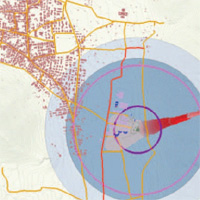Mobility Networks And Safety
Abstract
A key point to explore the relationship between mobility and security is the role of mobility networks for ensuring territorial safety with respect to natural and man-made hazards. For many years, increasing the security of settled communities against hazards has represented one of the main target of the strategies meant to address a sustainable urban and territorial development. Mobility networks play a crucial role in that context. They represent a basic support for the community’s everyday life, on which health, comfort and a large part of economic activities depend; moreover, they represent exposed elements often characterized by high vulnerability to different hazards and, in the meanwhile, strategic equipments for the emergency management. The damage or the reduced functionality of those networks can increase the loss of human lives caused by an hazardous event as well as produce relevant economic damages at medium and long term. Besides, by extending the investigation field from the networks meant as physical supports to the flows of goods along them, the impacts of an hazardous event on such elements can provoke relevant secondary events (toxic releases, explosions and so on). Although the relevance of the mobility networks in assuring territorial safety is at present largely recognized, risk analyses have been long focused on buildings’ vulnerability or, even where they have paid attention to the mobility networks, they mainly stressed the physical damages that a given event could produce to the single elements of such networks. It is still recent the awareness that mobility networks represent a system, characterized by relevant interdependences: either because each element of the network is linked to all the others, or because there are several interdependences not only among the different typologies of network infrastructure, but also among network infrastructure and urban systems. Starting from the above assumptions, this paper points out the several aspects of the vulnerability of mobility networks and their relevance in determining the vulnerability of a territorial or urban system to hazardous events. Therefore, it is suggested an in-depth investigation of the concept of vulnerability of the mobility networks, in order to highlight the aspects mostly analyzed until now. Finally, in the last part of the paper, it is presented a case study in the Campania Region targeted to point out how the traditional risk analyses, usually based on single hazardous events, can sometimes led to invest in the improvement and adjustment of mobility networks which, targeted to increase the security of a territory, on the contrary, produce an increase of the territorial vulnerability. The case study is part of a wider study developed by the authors within the National Project 2006-2008 entitled “Early Warning Systems: technical, urban planning and communication aspects”.Downloads

Copyright (c) 2014 Tema. Journal of Land Use, Mobility and Environment

This work is licensed under a Creative Commons Attribution 4.0 International License.
Authors who publish in this journal agree to the following:
1. Authors retain the rights to their work and give in to the journal the right of first publication of the work simultaneously licensed under a Creative Commons License - Attribution that allows others to share the work indicating the authorship and the initial publication in this journal.
2. Authors can adhere to other agreements of non-exclusive license for the distribution of the published version of the work (ex. To deposit it in an institutional repository or to publish it in a monography), provided to indicate that the document was first published in this journal.
3. Authors can distribute their work online (ex. In institutional repositories or in their website) prior to and during the submission process, as it can lead to productive exchanges and it can increase the quotations of the published work (See The Effect of Open Access)
